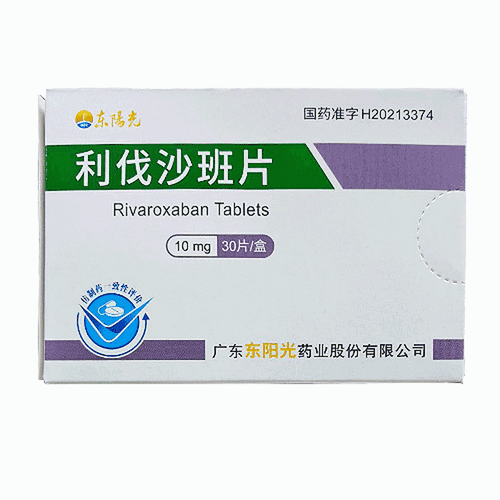Product Overview
Drug Name: Rivaroxaban Tablets (Pusitong)
Generic Name: Rivaroxaban Tablets
Specifications: 20mg x 14 tablets
Manufacturer: Qilu Pharmaceutical Co., Ltd.
Approval Number/Production License Number: National Medicine Standard H20213382
Expiration Date: 24 months
Adverse Reactions: The following adverse reactions are discussed elsewhere in this package insert: 1. Increased risk of stroke after premature discontinuation of rivaroxaban in patients with non-valvular atrial fibrillation (see Warnings and Precautions). 2. Risk of bleeding (see Precautions). 3. Spinal/epidural hematoma (see Warnings and Precautions). The most common adverse reaction with rivaroxaban is bleeding (see Precautions). Please read the package insert for details.
Precautions: Close observation is recommended throughout anticoagulant therapy. Premature discontinuation of rivaroxaban increases the risk of thromboembolic events. Premature discontinuation of any oral anticoagulant, including rivaroxaban, in the absence of adequate alternative anticoagulant therapy increases the risk of thromboembolic events. In clinical trials, an increased incidence of stroke was observed during the conversion from rivaroxaban to warfarin in patients with nonvalvular atrial fibrillation. If rivaroxaban must be discontinued prematurely for reasons other than pathological bleeding or completion of treatment, consider administering an alternative anticoagulant. Risk of Bleeding: Rivaroxaban increases the risk of bleeding and may cause serious or fatal bleeding. The risk of thromboembolic events must be weighed against the risk of bleeding when deciding whether to use rivaroxaban in patients at increased bleeding risk. As with other anticoagulants, patients taking rivaroxaban should be carefully observed for signs of bleeding. Caution is recommended in settings with a higher risk of bleeding. If severe bleeding occurs, rivaroxaban must be discontinued. In clinical studies, patients receiving long-term rivaroxaban therapy experienced more mucosal bleeding (i.e., epistaxis, gingival bleeding, gastrointestinal bleeding, and genitourinary bleeding) and anemia compared with patients receiving VKA therapy. Therefore, in addition to adequate clinical observation, appropriate interpretation of laboratory hemoglobin/hematocrit test results can help detect occult bleeding. Patients at increased risk of bleeding should be closely monitored for bleeding complications and signs and symptoms of anemia after treatment initiation. For the postoperative population, bleeding can be detected promptly through regular physical examinations, close observation of surgical wound drainage, and regular hemoglobin measurement. Any unexplained decrease in hemoglobin or blood pressure should prompt an investigation for the source of bleeding. Signs and symptoms of blood loss should be promptly assessed, and the need for blood replacement therapy should be considered. Rivaroxaban should be discontinued in patients with active pathological bleeding. The terminal elimination half-life of rivaroxaban is 5 to 9 hours in healthy subjects aged 20 to 45 years. Concomitant use of other medications that affect hemostasis increases the risk of bleeding. These medications include aspirin, P2Y12 platelet inhibitors, other antithrombotic agents, fibrinolytics, and nonsteroidal anti-inflammatory drugs (NSAIDs). Concomitant use of combined P-gp and strong CYP3A4 inhibitors (e.g., ketoconazole and ritonavir) increases rivaroxaban exposure and may increase the risk of bleeding. Although routine exposure monitoring is not necessary during rivaroxaban therapy, in certain circumstances, such as overdose and emergency surgery, rivaroxaban levels can be measured using a standard anti-factor Xa assay. Knowledge of rivaroxaban exposure can aid clinical decision-making. Reversal of the Anticoagulant Effect: No specific inhibitor is available for rivaroxaban. Due to its high binding to plasma proteins, rivaroxaban cannot be observed. Protamine sulfate and vitamin K are not expected to affect the anticoagulant activity of rivaroxaban. Partial reversal of the prolonged prothrombin time has been observed in healthy subjects following administration of prothrombin complex concentrate (PCC). Other procoagulant reversal agents, such as activated prothrombin complex concentrate (APCC) or recombinant factor VIIa (rFVIIa), may be used. See [Overdosage]. Spinal Puncture/Epidural Anesthesia: When undergoing an epidural or spinal puncture, patients receiving antithrombotic medications to prevent thrombotic complications are at risk for epidural or spinal hematomas, which may result in long-term permanent paralysis. The use of an indwelling epidural catheter after surgery or concomitant use of medications that affect hemostasis may increase the risk of these events. Traumatic or repeated epidural or spinal punctures may also increase this risk. Patients should be observed regularly for signs and symptoms of neurologic impairment, such as back pain, sensory or motor deficits (numbness, tingling, or weakness in the lower extremities), or bowel or bladder dysfunction. If neurologic impairment is observed, prompt diagnosis and treatment are essential. Before performing a spinal puncture, physicians should monitor the potential risks and risks of epidural hematomas in patients receiving anticoagulant therapy or those receiving anticoagulant therapy for hemostasis prevention. The epidural catheter should not be removed until 18 hours after the last dose of rivaroxaban. Rivaroxaban should be administered 6 hours after catheter removal. If a traumatic puncture is performed, rivaroxaban administration should be delayed for 24 hours. If the physician decides to administer an anticoagulant during epidural or spinal anesthesia/analgesia or spinal puncture, the patient should be monitored frequently for signs or symptoms of neurologic impairment. If signs or symptoms of a spinal hematoma are suspected, urgent diagnosis and treatment, including spinal cord decompression, should be initiated, even if this treatment does not prevent or reverse neurologic sequelae. Renal Impairment Prevention of Venous Thrombosis in Adult Patients Undergoing Elective Hip or Knee Replacement Surgery Avoid the use of rivaroxaban in patients with a CrCl <30 mL/min, as elevated rivaroxaban exposure and enhanced pharmacodynamic effects are expected in this patient population. Closely observe and promptly evaluate patients with a CrCl 30-50 mL/min for any signs or symptoms of blood loss. Patients who develop acute renal failure while taking rivaroxaban must discontinue treatment. Treatment of Deep Venous Thrombosis (DVT) to Reduce the Risk of Recurrent DVT and PE Following Acute DVT Avoid the use of rivaroxaban in patients with a CrCl <30 mL/min, as elevated rivaroxaban exposure and enhanced pharmacodynamic effects are expected in this patient population. For use in adult patients with non-valvular atrial fibrillation to reduce the risk of stroke and systemic embolism. Avoid using rivaroxaban in patients with CrCl <15 mL/min due to increased drug exposure. Assess renal function regularly as clinically indicated (i.e., more frequently if renal function may be impaired) and adjust treatment accordingly. Discontinue rivaroxaban if acute renal failure occurs during rivaroxaban use. Interactions with Other Drugs: Concomitant use of rivaroxaban is not recommended in patients taking systemic medications such as azole antifungals (e.g., ketoconazole, itraconazole, voriconazole, and posaconazole) or HIV protease inhibitors (e.g., ritonavir). Because these drugs are potent inhibitors of CYP3A4 and P-gp, concomitant use may result in clinically significant increases in rivaroxaban plasma concentrations (average 2.6-fold), increasing the risk of bleeding. Use with caution in patients taking concomitant medications that affect hemostasis (e.g., NSAIDs, acetylsalicylic acid, platelet aggregation inhibitors). Appropriate prophylactic therapy should be considered for patients at risk for developing ulcerative gastrointestinal disease. Other Bleeding Risks: As with other antithrombotic drugs, rivaroxaban is not recommended in patients with the following elevated bleeding risks: congenital or acquired bleeding disorders; uncontrolled severe hypertension; other gastrointestinal diseases without active ulcers that can lead to bleeding complications (e.g., inflammatory bowel disease, esophagitis, gastritis, and gastroesophageal reflux disease); vasculogenic retinopathy; or a history of bronchiectasis or pulmonary hemorrhage. Venous Thromboembolism Prevention in Hip Fracture Surgery: No interventional clinical studies have evaluated the efficacy and safety of rivaroxaban in patients undergoing hip fracture surgery. Patients with Prosthetic Heart Valves: The safety and efficacy of rivaroxaban have not been studied in patients with prosthetic heart valves; therefore, there are no data to support that rivaroxaban 20 mg (15 mg for patients with moderate or severe renal impairment) provides adequate anticoagulation in this patient population. Rivaroxaban is not recommended for use in such patients. Patients with acute pulmonary embolism: Rivaroxaban is not recommended for use in these patients. Dosage Recommendations Before and After Invasive Procedures and Surgeries: If an invasive procedure or surgery is required, rivaroxaban should be discontinued for at least 24 hours before the intervention, if possible and based on the physician's clinical judgment. If the procedure cannot be postponed, the increased risk of bleeding should be weighed against the urgency of the intervention. After the invasive procedure or surgery, rivaroxaban should be resumed as soon as clinically possible and adequate hemostasis has been achieved. Excipient Information: Rivaroxaban tablets contain lactose. Patients with rare hereditary conditions of lactose or galactose intolerance, Lapp lactase deficiency, or glucose-galactose malabsorption should not take this medication. Effects on the Ability to Drive and Use Machinery: Rivaroxaban has minimal effects on the ability to drive and use machinery. Adverse reactions such as syncope (frequency: rare) and dizziness (frequency: common) have been reported. Patients experiencing these adverse reactions should not drive or operate machinery.
Contraindications: 1. Patients hypersensitive to rivaroxaban or any of the excipients in the tablets. 2. Patients with clinically significant active bleeding. 3. Lesions or conditions with a significant risk of major bleeding, such as current or recent gastrointestinal ulcers, malignant tumors with a high bleeding risk, recent brain or spinal cord injury, recent brain, spinal, or ophthalmic surgery, recent intracranial hemorrhage, known or suspected esophageal varices, arteriovenous malformations, vascular aneurysms, or major spinal intravascular malformations. 4. Concomitant treatment with any other anticoagulants, such as unfractionated heparin (UFH), low molecular weight heparins (enoxaparin, dalteparin, etc.), heparin derivatives (fondaparinux, etc.), and oral anticoagulants (warfarin, apixaban, dabigatran, etc.), is contraindicated, except when switching from other treatments to rivaroxaban or vice versa, or when administering the dose of UFH required to maintain a central venous or arterial catheter. 5. Patients with liver disease associated with coagulation abnormalities and clinically relevant bleeding risk, including patients with cirrhosis reaching Child-Pugh class B and C. 6. Pregnant and lactating women.
Packaging Unit: Box
Main Ingredient: Rivaroxaban.
Appearance: 10 mg: Light red film-coated tablets, appearing white or off-white after removal of the coating; 15 mg: Red film-coated tablets, appearing white or off-white after removal of the coating; 20 mg: Brownish red film-coated tablets, appearing white or off-white after removal of the coating.
Intended Population: Adults
Pregnancy/Lactation Use: Pregnancy. The safety and efficacy of rivaroxaban in pregnant women have not been established. Animal studies have shown reproductive toxicity. Due to the potential for reproductive toxicity, the risk of endogenous bleeding, and the fact that rivaroxaban crosses the placenta, rivaroxaban is contraindicated in pregnant women. Women of childbearing potential should use contraception during treatment with simvaroxaban. Parturition: The safety and efficacy of rivaroxaban during labor and delivery have not been studied in clinical trials. However, in animal studies, maternal hemorrhage and maternal and fetal death occurred at a dose of 40 mg/kg rivaroxaban (approximately the highest unbound drug exposure in humans at a 20 mg/day human dose). Lactation: The safety and efficacy of rivaroxaban in lactating women have not been established. Data from animal studies indicate that rivaroxaban passes into breast milk. Therefore, rivaroxaban is contraindicated in lactating women. A decision must be made whether to discontinue breastfeeding or rivaroxaban treatment. Fertility: Specific studies evaluating the effects of rivaroxaban on fertility have not been conducted in humans. In a fertility study in male and female rats, no effects were observed. Women of childbearing potential: Women of childbearing potential who require anticoagulant therapy should consult a physician.
Pediatric Use: There is no evidence to establish the safety and efficacy of rivaroxaban in children aged 0 to 18 years. Therefore, rivaroxaban is not recommended for use in children under 18 years of age.
Geriatric Use: Dosage for elderly patients should be determined based on bleeding risk, renal function, and general status; in most cases, no dose adjustment is required. In the rivaroxaban RECORD 1-3 clinical studies, approximately 54% of all patients were 65 years of age or older, of whom approximately 15% were 75 years of age or older. In the ROCKET AF study, approximately 77% of patients were 65 years of age or older, of whom approximately 38% were 75 years of age or older. In the Einstein DVT, PE, and Extension study, approximately 37% of patients were 65 years of age or older, of whom approximately 16% were 75 years of age or older. In clinical trials, the efficacy of rivaroxaban in elderly patients (65 years of age or older) was similar to that observed in patients younger than 65 years of age. While the incidence of thrombotic and bleeding events was higher in these elderly patients, the risk profile was consistent with benefit across all age groups.
Storage
Store tightly closed.






